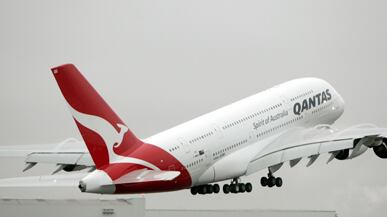Chilling Close Calls
Close calls don’t show up in airline accident statistics. But they can be more consequential than actual crashes. Two incidents in 2010 have big implications for the future of air safety. They have not had the attention they deserve: The fact is that the two most advanced airliners in the world came very close to crashing.

Strangely, these close calls happened within five days of each other:
On November 4, an Airbus A380 flown by the Australian airline Qantas, with 433 passengers and 26 crew aboard, suffered a catastrophic engine failure a few minutes after taking off from Singapore. This is the super-jumbo, capable of carrying as many as 800 passengers. The loss of an A380, early in its history, would have been the equivalent for aviation of the loss of the Titanic for ocean liners—and, like the puncturing of the Titanic’s supposedly impregnable hull, the incident raises questions about the A380’s structural integrity.
On November 9, a Boeing 787 Dreamliner, on a test flight and making its final approach at Laredo, Texas, suffered a fire so sudden and serious that the pilots were left with only a final emergency source of power and very basic flight controls to make their landing. The 787 is already almost three years late because of serial technical crises. Losing a test airplane before any airline gets one fit to fly could have seriously jeopardized both the program and Boeing. As it was, all 787 test flights have been grounded while the cause of the fire is investigated.
Africa is a notorious black hole when it comes to modern navigation aids and strictly enforced safety standards.
Fortunately, one thing common to both incidents was the skill of the pilots.
By chance, the Qantas A380 had five experienced pilots on the flight deck, rather than the normal two. Three, in jump seats, were a combination of observers and checkers. So demanding was the cascade of failures after bits of an engine tore through the A380’s wings that it took all five pilots to get the airplane back to the runway at Singapore. In Texas, the two Boeing test pilots, with a cabin filled with smoke, had only two minutes to get the 787 down in one piece.
These emergencies matter. Each airplane represents, to different degrees, major leaps in technology. And the technology is driven by two unremitting pressures—to reduce the cost of flying and, at the same time, to cut back by as much as 30 percent the environmental impact of flying.
To achieve these ambitious goals, more and more of the task of flying is being handed over to computers. That is because computers, as long as they work, do these tasks far more efficiently than humans.
Beyond doubt, the steady advance of automation on airplane flight decks has greatly helped to reduce accidents. At the same time, though, it has placed fewer and fewer demands on pilots during most stages of a flight. As a result, pilots themselves have become concerned about the loss of the physical “feel” of flying and the consequences of inattention.
Airbus and Boeing have different approaches to cockpit automation. They are philosophical and technical. But, essentially, both companies have handed over management of minute-by-minute control and monitoring of the airplane to computers.
But what happens when the computers can’t cope? Aboard the Qantas A380, the computers were overwhelmed by a firestorm of error messages and basically gave up. It took the crew 50 minutes—an intense 50 minutes of improvisation—to figure out for themselves how to return to Singapore. Even then, left without normal power for braking, they managed to stop only 150 meters from the end of the runway—a runway that ended at the edge of water.
Both the A380 and the 787 have backup systems, mandated by regulators, that should intervene when the primary systems are lost. In neither airplane did these work as they should have. Shrapnel from the A380’s exploding engine cut through a wing and sliced through both primary and backup systems. Experts say that this should not be possible—that the two systems should not be so close to each other at any point that an impact can remove both. In the case of the 787, faulty software shut down backup systems unaffected by the fire, and the pilots were left using scant power from one small emergency generator.
In an effort to make the 787 greener, it uses much more electrical power from a separate source rather than drawing power from its jet engines. The fire erupted suddenly in the bay housing the electrical nerve center. This potentially catastrophic failure was caused, apparently, by one small, loose component creating a short circuit. With any new system will come new and unforeseen reasons for failure. That is what testing is meant to discover. The 787 is built mostly from composites, not metal. And before the electrical failure there were unexpected structural failures, all of these pushing back further and further the readiness of the Dreamliner for airline service—barring new problems, the first one will not be delivered to an airline until mid-2011.
Airbus, which moved faster and earlier to cockpit automation than Boeing, has problems beyond the A380. New concerns arose in 2010 about the automated flight management system aboard its single-aisle A320 family of airplanes, which pioneered fly-by-wire in airliners. There are 4,400 of these airplanes flying and they have been around for 20 years, but glitches keep being exposed. In August an A321 (a larger version of the A320) en route from Khartoum to Beirut suddenly lost all its cockpit displays and computer controls. The airplane shuddered, and without pilot input banked sharply and veered 20 miles off course. After several minutes the pilots regained control by using backup systems. Investigators are still investigating this and other similar incidents.
Also hovering over Airbus is the still unexplained loss of Air France Flight 447 over the South Atlantic in 2009, taking 228 passengers with it. Three searches for the wreck have so far failed to locate it, and a fourth is now due to begin next February. A total failure of the flight management system aboard the Airbus A330 is at the heart of the mystery.
A few years ago, some airplane designers were telling me that future technology would, at the very least, turn human pilots into mere bystanders, and that the time would eventually come when they wouldn’t be needed at all. I’m not hearing that now. Flight deck automation is proving to be far more fallible than advertised. The A380 and 787 incidents have both, inadvertently, shown how indispensable the human factor is.
The World-Wide Tally: Rapid Growth, Deadly Failings.
The other side of the coin, pilot error, produced two of the year’s worst crashes. On May 22, a Boeing 737 of Air India Express, landing on a difficult mountain-top runway at Mangalore, India, overshot and crashed into a ravine. One-hundred-fifty-two passengers were killed. The pilot (Serbian with long experience) had been dozing during the flight and was still disoriented when attempting to land. And the April 10 crash in Russia of a Polish Air Force Tu-154, killing all 96 on board including the Polish president, was caused because the pilot yielded to demands from his VIP passengers to attempt a landing in extremely poor visibility.
All in all in 2010, nearly 800 passengers died in 16 crashes. Take a look at where these crashes occurred: Lebanon, Brazil, Libya, Suriname, Afghanistan, India, Congo, Pakistan, Russia, Colombia, Nepal, China, Venezuela, and Cuba.
Many of these are countries where the growth of air travel, driven by new budget carriers, is outstripping the fitness of air-traffic control resources. Moreover, pilots are often fatigued, being pushed to fly too many hours. The quality of pilot training and monitoring is extremely variable. Aircraft maintenance standards are patchy. Critically, there is no enforceable international air-safety regime.
For passengers this means that once you venture beyond North America, Europe, and the more advanced parts of Asia, where regulators are vigilant and standards consistently applied, risks increase. Africa, for example, is a notorious black hole when it comes to modern navigation aids and strictly enforced safety standards.
International air travel is now a vast, interlocking system—and growing by the day. You can board a flight in the U.S. and, without realizing it, rapidly find yourself transferred through connections into parts of the world where the safety regimes are problematic. Until there are globally consistent safety standards—and don’t hold your breath—when you book an international flight you need to know who might end up being responsible for your safety.
Clive Irving is senior consulting editor at Conde Nast Traveler, specializing in aviation—find his blog, Clive Alive, at CliveAlive.Truth.Travel.






